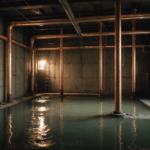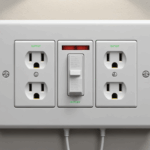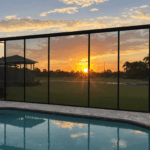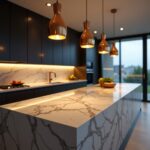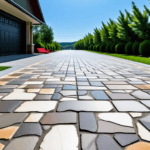In today’s competitive real estate market, first impressions matter more than ever for potential buyers evaluating your property. Enhancing your home’s curb appeal is a strategic investment that can significantly amplify your property’s marketability and ultimately bolster its value. According to the National Association of Realtors (NAR), a well-maintained exterior can increase property value by up to 7%. Buyers often form their perception of a home within minutes of arriving, underscoring the critical role of curb appeal. By prioritizing the exterior of your house, you set the stage for a positive viewing experience before prospective buyers even step inside.
The concept of curb appeal doesn’t merely revolve around aesthetics; it involves functional updates that contribute to the home’s overall maintenance and appeal. Given that the exterior is subject to varying weather conditions and environmental impacts, periodic renovations also help in prolonging the life of your house’s exterior components, such as siding, roofing, and landscaping. From an investment perspective, exterior projects typically offer compelling returns. In fact, according to Remodeling’s 2023 Cost vs. Value report, exterior improvement projects often yield higher returns on investment compared to interior updates. This makes enhancing curb appeal a practical step for homeowners aiming to maximize their home value before putting it on the market.
To start enhancing your home’s curb appeal, begin by evaluating the condition of your home’s façade—this includes any visible parts of the house from the street such as the front door, windows, and garage. A fresh coat of paint, particularly in neutral tones like soft greys, whites, or tans, is a simple yet impactful change. According to experts, updating your home’s color palette can uplift the overall vibe and attract buyers seeking move-in ready properties.
Landscaping plays a pivotal role in elevating curb appeal, as well-manicured lawns and gardens create an inviting atmosphere. Consider incorporating low-maintenance plants such as boxwoods, lavender, or ornamental grasses, which not only add beauty but also reflect an understanding of sustainable gardening practices. Adding a layer of mulch can give your flowerbeds a polished look while also helping conserve moisture. If your budget allows, investing in professional landscaping can offer a transformative “wow” factor.
Moreover, assessing the condition of your home’s paths and driveways is imperative. Cracked pavements or uneven walkways can be safety hazards that turn potential buyers away. Simple fixes like power washing, patching cracks, or even replacing sections of concrete can resolve these issues and create a more inviting entrance. Ensure your house numbers are visible and stylish, as they are both functional and decorative—details as small as this contribute to a cohesive aesthetic appeal.
Lighting is another essential facet of curb appeal. Adequate exterior lighting not only improves safety but also enhances the architectural features of your home during evening showings. Incorporate a mix of path lights, wall lanterns, and spotlights to highlight landscaping or unique architectural details. According to Zillow, homes with well-thought-out lighting plans tend to spend less time on the market and typically garner more attractive offers.
Investing time and resources into enhancing curb appeal can significantly pay off. As potential buyers drive past or arrive for a viewing, the carefully curated exterior will invite them into the home, echoing a conscientious attention to detail that continues through the interior. This seamless transition ultimately positions your home as a leading contender in the competitive real estate market, reflecting desirability and adding substantial value.
Upgrade kitchen features
Making upgrades to your kitchen can be one of the most effective ways to increase your home’s value before selling it. As the heart of the home, the kitchen is a space where functionality meets style, and prospective buyers often focus their attention here. Kitchen improvements consistently top the list of desired renovations due to their substantial return on investment. According to Remodeling Magazine’s Cost vs. Value report, even a minor kitchen remodel can recoup a significant portion of the costs, making it a smart real estate investment.
The key to a successful kitchen renovation is balancing aesthetics with functionality. Start by focusing on essential upgrades such as new countertops, updated cabinet doors, or fresh tiling. Materials like granite, quartz, or marble provide a luxurious feel to countertops, while modern cabinets in neutral colors can update the look without overwhelming buyers. In terms of flooring, durable materials such as hardwood or ceramic tiles are preferred for their longevity and easy maintenance, appealing to potential buyers who appreciate low-maintenance homes.
A modernized kitchen should also incorporate energy-efficient appliances. Contemporary buyers are eco-conscious, and appliances with Energy Star ratings not only lower utility bills but also add significant appeal to your home. Upgrade outdated appliances and consider adding features like a smart refrigerator or a convection oven, which can make your kitchen seem more high-tech, thereby increasing its perceived value.
Don’t overlook minor details like lighting fixtures and hardware. Swapping out builder-grade lights for stylish pendant lights or under-cabinet lighting can dramatically change the ambiance. Similarly, updated hardware in brushed nickel or matte black can provide a contemporary touch while being budget-friendly.
While undertaking these renovations, maintaining a palette that appeals to the broadest range of buyers is essential. Neutral tones and classic styles help ensure your kitchen remains universally appealing, making it easier for prospective buyers to envision the space as their own. These renovation tips, when executed thoughtfully, not only enhance the kitchen’s functionality and style but also make it a central selling point that significantly boosts your home value in the competitive real estate market.
- Even minor kitchen upgrades, like updating cabinet doors or hardware, can significantly increase home value.
- Focus on durable and attractive materials such as granite or quartz countertops to catch buyer attention.
- Energy-efficient appliances are crucial; look for Energy Star-rated products to highlight in listings.
- Modern lighting solutions, such as under-cabinet lights, enhance both function and appearance.
- Stick to neutral color schemes to appeal to a wider range of buyers and ease their buying decision.
Modernize bathrooms
Modernizing the bathrooms in your home is another strategic move that can significantly boost your property’s value and appeal in the real estate market. Buyers are increasingly drawn to modern, spa-like bathrooms that offer both style and functionality. However, it’s essential to approach bathroom upgrades with careful planning to avoid common pitfalls that could reduce the return on your investment.
One frequent mistake homeowners make is over-personalization. While bold tiles, unique fixtures, or bright colors may reflect your personal style, they may not resonate with potential buyers who prefer neutral tones. Sticking to a neutral color palette with timeless finishes can create a universally appealing space that allows buyers to imagine their own decor. Whites, soft greys, and beiges generally work well, creating a clean, contemporary look that can also make smaller bathrooms feel more spacious.
Another common error is ignoring the importance of proper ventilation. Even the most beautifully designed bathroom can suffer from mold, mildew, and moisture damage if there isn’t effective ventilation in place. Ensuring that your bathroom remodel includes a high-capacity exhaust fan or even upgrading an existing one can help maintain air quality and prevent potential damage to your investment. Buyers will appreciate a bathroom that not only looks good but also functions well over time.
Homeowners may also focus too much on aesthetics at the expense of functionality. While updating the aesthetic elements is important, focusing on practical aspects like storage solutions can greatly enhance a bathroom’s usability. Consider adding clever storage options such as recessed shelves, extended vanities, or built-in cabinet spaces. These can make the bathroom appear more organized and spacious, meeting the functional demands of modern buyers.
Lighting is another critical aspect that is often overlooked. Relying solely on harsh overhead lighting can give your bathroom a clinical feeling. Incorporate layered lighting solutions that include softer ambient lighting alongside directed task lights around mirrors. This not only makes daily routines like shaving or applying makeup easier but also adds to the overall ambiance, making the bathroom inviting and luxurious.
Ignoring eco-friendly features can be another misstep. Many buyers today are eco-conscious and favor homes with water-saving fixtures. Investing in low-flow toilets, water-efficient showerheads, and faucets with aerators can not only attract these buyers but also highlight your home in the listings as eco-friendly. These sustainable choices often translate to cost savings on utility bills, providing an additional incentive to prospective buyers.
Finally, skimping on quality fixtures and finishes to save money can backfire. In areas where humidity and moisture are prevalent, like bathrooms, choosing durable materials and quality workmanship will pay off. High-quality fixtures in finishes like brushed nickel or chrome offer durability and can withstand the wear and tear of daily use, contributing to the perceived value of the space.
By avoiding these common mistakes and incorporating thoughtful renovation tips, homeowners can modernize their bathrooms in a way that enhances both the home value and the satisfaction of potential buyers.
Improve energy efficiency
Improving your home’s energy efficiency is a powerful avenue to boosting home value while appealing to a growing number of eco-conscious buyers in the real estate market. Energy efficiency isn’t just a trending topic; it’s a long-term investment strategy that enhances comfort, reduces utility bills, and signals a property’s modernity and sustainability to prospective buyers. According to the National Association of Home Builders, energy-efficient upgrades can significantly impact a home’s resale potential.
Start by evaluating your home’s insulation. Proper insulation is crucial for maintaining a comfortable indoor temperature and reducing energy consumption. By ensuring that your attic, walls, and basement are well insulated, you can prevent heat loss during winter and keep your home cooler in the summer. This not only minimizes the workload on your HVAC system but also sends a positive signal to buyers looking for cost-effective and environmentally friendly homes.
Consider replacing old windows and doors with energy-efficient models. Double or triple-pane windows with low-emissivity coatings can significantly reduce heat transfer, thereby lowering heating and cooling costs. Similarly, energy-efficient exterior doors with proper seals help minimize drafts and improve thermal performance. Ensure that all windows and doors are properly installed to optimize these benefits.
Another vital upgrade to consider is enhancing the efficiency of your heating, ventilation, and air conditioning (HVAC) system. Outdated units can be major energy wasters, so upgrading to a modern, high-efficiency system is a worthy investment. Look for units with a high Seasonal Energy Efficiency Ratio (SEER) for cooling and a high Heating Seasonal Performance Factor (HSPF) for heating to ensure optimal performance and lower bills for the new owners.
Installing a programmable thermostat is a simple yet highly effective measure that allows for better management of heating and cooling patterns. Some advanced models even adapt to your habits over time for maximum efficiency. These thermostats can provide significant cost savings and are an attractive feature for tech-savvy buyers who appreciate smart home technologies.
Lighting is another area where you can increase energy efficiency without breaking the bank. Replace traditional incandescent lights with LED or CFL bulbs, which consume far less energy and have a much longer lifespan. Additionally, consider incorporating motion sensor lighting for outdoor areas and dimmers for living spaces to further optimize energy usage.
Highlight your energy-efficient upgrades through strategic marketing in your real estate listing. Use labels like “Energy Star” and emphasize the tangible benefits such as lower monthly energy costs, improved home comfort, and environmental responsibility. These features can be particularly persuasive and make your home stand out in a competitive market.
By embracing energy-efficient renovation tips, you not only enhance the overall appeal and value of your home but also contribute positively to the environment. Taking these steps not only ensures a more marketable and valuable property but also aligns with your role as a responsible homeowner committed to sustainable practices. Let these changes ignite the spark needed to seal the deal in your favor, bringing you closer to your goal of maximizing your home’s potential in the ever-evolving real estate landscape.
Create additional living space
Creating additional living space is a transformative renovation that can significantly increase your home value and appeal to a broader range of buyers. Adding more living space offers versatility and adaptability, catering to the diverse needs of potential buyers, be it a growing family, a home office for remote work, or a recreational area for leisure.
Start by evaluating underutilized areas of your home, such as the basement or attic. Converting these spaces into functional living areas can dramatically enhance your property’s living square footage without the need for extensive extensions. For instance, finishing a basement into a family room, guest suite, or entertainment zone is a popular choice among homeowners. Ensure the space is waterproofed properly and consider adding modern touches like recessed lighting and neutral flooring to make it inviting and livable.
If structural changes are within your budget, consider building an addition. Whether it’s an extra bedroom, sunroom, or a multi-purpose room that can serve various functions, adding new square footage directly increases the home’s appeal and market value. For those with small plots, constructing a second-story addition may be feasible, offering the benefit of increased space while maintaining yard area.
For smaller-scale projects, consider creating an open floor plan. Removing non-load-bearing walls between common areas like the kitchen and living room can open up the space, making it feel larger and more connected. This modern layout is highly sought after in real estate markets for its adaptability and causal comfort.
Incorporating outdoor living areas can also be a cost-effective way to expand usable space. Decks and patios provide valuable square footage for entertaining or relaxing. Additions such as a pergola, fire pit, or outdoor kitchen can extend the living space’s usability throughout different seasons.
Be mindful of obtaining the necessary permits and adhering to local building codes before embarking on any structural changes. Highlighting these newly created spaces in your real estate listing is crucial. Include professional photos and descriptions that showcase their function and versatility, helping potential buyers easily envision themselves in the space.
By creatively maximizing and enhancing your home’s living areas, you help ensure that it stands out in a competitive market, driving buyer interest and ultimately increasing its overall value.
- What is the most cost-effective way to add living space to my home?
- Converting underutilized areas like basements or attics into livable space is generally the most cost-effective option. This strategy utilizes the existing structure, minimizing costs associated with major extensions while enhancing your home’s square footage and appeal.
- Will adding a deck or patio increase my home’s value significantly?
- Yes, outdoor living spaces like decks and patios are highly desirable and can increase your home’s value. They offer additional space for entertainment and relaxation, enhancing your property’s appeal to potential buyers.
- How can I incorporate an open floor plan in my home?
- Removing non-load-bearing walls between common areas such as the kitchen and living room can create an open floor plan. This design improves the home’s flow and spaciousness and is a popular choice among modern homebuyers.
- Do I need permits to add a room to my house?
- Yes, most home additions require building permits to ensure compliance with local codes and regulations. It’s important to consult with a professional or your local building authority to understand the requirements before beginning renovations.
- What should I consider when finishing a basement?
- When finishing a basement, consider proper waterproofing and moisture control to prevent damage. Additionally, use neutral finishes and adequate lighting to create an inviting atmosphere that appeals to potential buyers.




